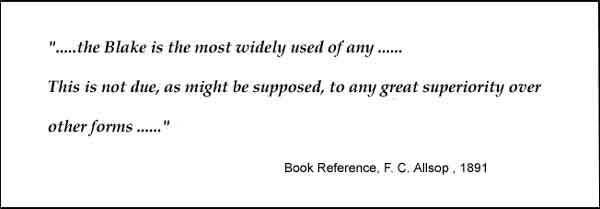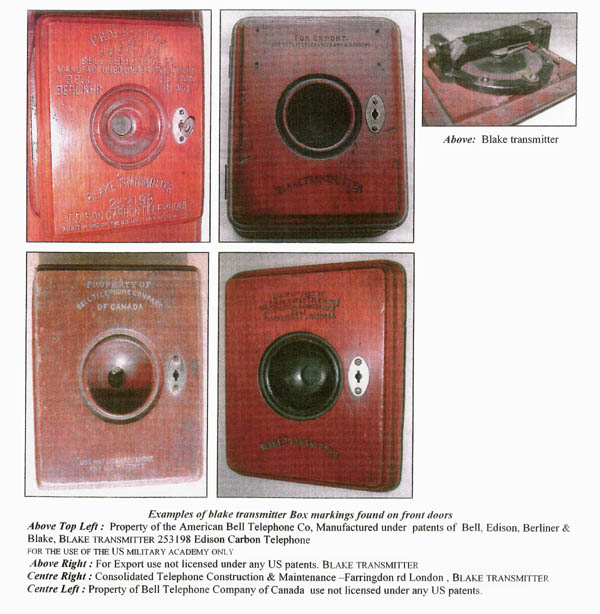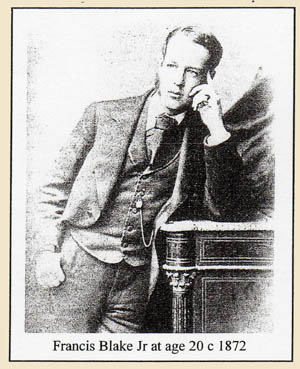| |||||
|
This article was originally published in the Australian Historic Telephone Society Newsletter, October 2005. It is reproduced here by kind permission of the authors. Blake TransmittersText by Linley Wilson, Pictures by Marco Laudani
For nearly twenty years after Bell commercialized the telephone, Francis Blake's transmitter was dominant in America and used worldwide, including in Australia. If it was not the best, what explains that dominance, and the iconic significance of Blake transmitters to collectors and historians today?
Here we discuss the operation and construction of the Blake transmitter and also the dynamics of its adoption, promotion and use. Blakes were not only manufactured by their original (Bell) patent owners. They were made under licence by companies across the world, some of which were the Consolidated Telephone Co. and the National Telephone Co. from England; others by U.S. companies like the Manhattan Supply Co., Gilliland Electric, Post and Telegraphs, DeVeau, ….
Their distinctive wooden cases were originally covered with patent dates, and the names of the other great players in the field - Berliner, Bell, and Edison. Some were stamped "Blake Transmitter" only. A lot of source literature from the author's collection was used for this article (beautifully complemented by Marco's resource pictures). The main books and periodicals are listed as full citations at the end. In the text, references and quotes are cited by author and name in brackets, allowing full title identification from the reference list. Many other works have also informed this contribution to the debate - for such a complex matter cannot finally be summed up by one author - now or then. Why then the Blake? In 2005, when few people can remember life without telecommunications, can we really understand how people , 120 years ago, viewed inventors who said they talked over wires without electricity? Hardly anyone then understood, even vaguely, the physics involved, or could visualise the history-changing developments arising out of these early, imperfect telephones. Is it surprising that in the turmoil of trial and error, and constant discouragement, first-class ideas were stillborn from lack of funds and business knowledge, or because some vital factor for commercial success was missing, and other projects were more pressing? Conversely, lesser inventions might be more fortunately placed and backed by more influential people, and become world leaders in their field. So it was that Francis Blake's invention came to American Bell at the precise moment to ensure its place in history. A thumbnail historical overview is helpful here. Bell had started the telephone business 2 years before being offered Blake's transmitter in 1878 - but only just, because although his first commercial instruments "listened" fairly well, they didn't talk too clearly - or loudly. This nearly sank the Bell enterprise once their early rivals, Western Union, got something (relatively) superior in Edison's carbon transmitter.
Terminology "there are, fundamentally, two types of transmitters: 1) those that use the energy in sound waves to generate an electric current (magneto-motive types) and 2) those that use this energy to modify an existing electric current produced by batteries (variable resistance types)" (Meyer, 1995). Bell's was in Class 1, and so produced low volume, imperfect speech over short lines only, relying solely on tiny currents generated by moving the iron diaphragm in the field of a magnet. Later introduction of a battery boosted performance a bit, but it was still a receiver forced to act as a transmitter. Note that this electromagnetic receiver, whether listening or speaking, was itself called a "telephone" for many years. Confusingly, Phillip Reis (first to use the word "telephone" [German "telefon"] gave that name exclusively to the speaking part of his controversial instrument (Thompson, 1883) . However in this article it will be referred to as a microphone transmitter, being one of Class 2 (above) - ie: "variable resistance transmitters" which all have some way to vary an existing battery current. For this discussion, these either work on the "microphonic principle" (below) or some other way. Pedigree of Microphone Transmitters Depending on whom we read, the first variable resistance transmitter was a microphone type by Reis (1860). Authors connected to Bell categorically deny that this transmitted speech, while others, then and now, make a serious case for Reis's priority in speech-transmitting microphones. Elisha Grey, the famous "also ran", designed a type of variable resistance instrument that moved a wire up and down in conductive liquid to vary circuit resistance - an idea alleged by some to have been illegitimately copied into Bell's first patent (describing a similar device, never put into production). Given the commercial impracticality of talking into jars of acid, we move to the microphonic types by Thomas Edison (USA) and David Hughes (Britain). Both were said to have concurrently invented slightly different devices, using the same principle, causing an unseemly, media-induced, brawl between them over priority - Hughes didn't patent his , while Edison did, and he accused Hughes of pre-emptively giving away the secrets. (Hospitalier, 1883; Preece and Maier 1888) Herbert (1901) divides the practical, variable resistance , microphonic transmitters into 3 classes | |||||





